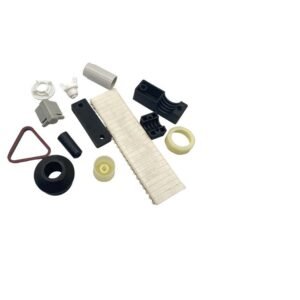Warping refers to the distortion of the shape of an injection-molded product compared to the mold cavity. It is a common defect in plastic products and can be influenced by various factors, including the mold structure, the thermophysical properties of the plastic material, and the conditions and parameters of the injection molding process. As the demand for high-quality plastic products increases, the degree of warping has become a critical factor in evaluating product quality.
Causes of Warping Defects
1. Unbalanced Molecular Orientation
The warping of thermoplastics is primarily influenced by the difference in radial and tangential shrinkage of the plastic part, which is a result of molecular orientation. During the molding process, polymer molecules tend to align along the melt flow direction more than in the perpendicular direction. This orientation creates internal stresses that lead to greater shrinkage along the flow direction, resulting in warping. To minimize this effect, it is essential to reduce the melt and mold temperatures, which can help relax the orientation stress. Heat treatment after demolding can further alleviate these stresses by allowing the part to cool slowly in warm water (37.5–43 degrees Celsius).
2. Improper Cooling
Inadequate cooling due to poor mold design or improper temperature control can lead to warping. This is particularly problematic in parts with varying wall thickness, as inconsistent cooling rates can cause differential shrinkage. To address this, the mold design should aim for uniform wall thickness, and sufficient cooling time should be maintained in the mold. Additionally, the cooling system should be optimized to ensure balanced cooling across all areas of the part.
3. Unreasonable Mold Gating System
The design of the mold gating system significantly impacts the shape and size of the plastic parts. A well-designed gate can help control the flow of molten material and reduce stress and deformation. The gate position should be chosen to avoid direct impacts on the core, and appropriate gate types should be selected based on the geometry of the plastic part to minimize warping.
4. Inadequate Demolding and Exhaust Design
Large unbalanced forces during demolding can cause significant warping. Factors such as insufficient demolding slope, improper ejector pin placement, and uneven ejection speeds can contribute to this issue. Mold design should include adequate slopes and a well-distributed number of ejector pins to ensure smooth ejection. For small to medium molds, anti-warping designs can be incorporated to counteract the expected warping.
5. Improper Process Operation
Various operational factors can lead to warping, including low injection pressure, slow injection speed, insufficient holding time, and uneven plasticization. Adjusting process parameters based on specific conditions can help mitigate these issues.
Warping and Twisting Checkpoints
1. Mold Temperature: Ensure the mold temperature is appropriate and extend cooling time if necessary.
2. Cooling Uniformity: Improve the cooling system to achieve even cooling of the plastic part.
3. Gate Selection: Choose a suitable gate form, often favoring multi-point gates.
4. Mold Alignment: Check and correct any eccentricities in the mold.
By understanding the causes of warping and implementing proper design and operational strategies, manufacturers can significantly reduce the occurrence of this defect in injection molded products, leading to improved product quality and performance.

